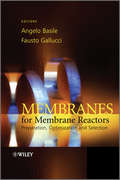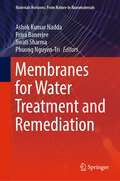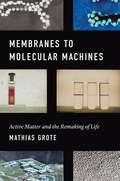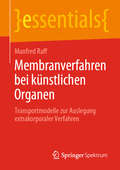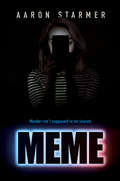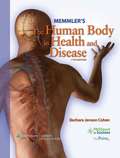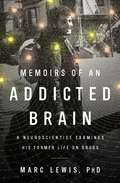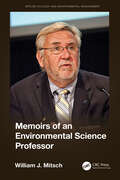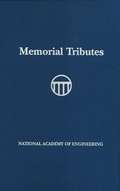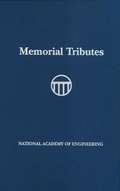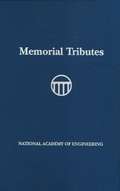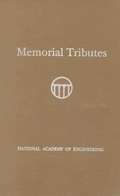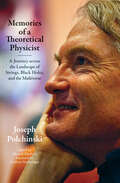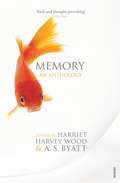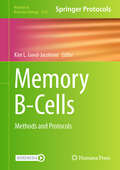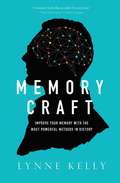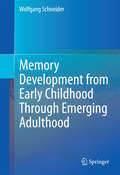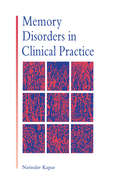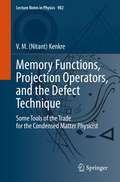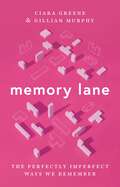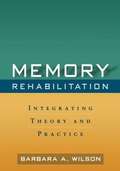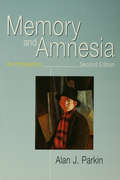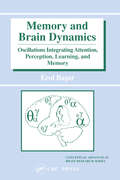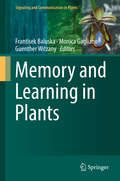- Table View
- List View
Membranes for Membrane Reactors
by Fausto Gallucci Angelo BasileA membrane reactor is a device for simultaneously performing a reaction and a membrane-based separation in the same physical device. Therefore, the membrane not only plays the role of a separator, but also takes place in the reaction itself.This text covers, in detail, the preparation and characterisation of all types of membranes used in membranes reactors. Each membrane synthesis process used by membranologists is explained by well known scientists in their specific research field.The book opens with an exhaustive review and introduction to membrane reactors, introducing the recent advances in this field. The following chapters concern the preparation of both organic and inorganic, and in both cases, a deep analysis of all the techniques used to prepare membrane are presented and discussed. A brief historical introduction for each technique is also included, followed by a complete description of the technique as well as the main results presented in the international specialized literature. In order to give to the reader a summary look to the overall work, a conclusive chapter is included for collecting all the information presented in the previous chapters.Key features:Fills a gap in the market for a scientific book describing the preparation and characterization of all the kind of membranes used in membrane reactorsDiscusses an important topic - there is increasing emphasis on membranes in general, due to their use as energy efficient separation tools and the 'green' chemistry opportunities they offerIncludes a review about membrane reactors, several chapters concerning the preparation organic, inorganic, dense, porous, and composite membranes and a conclusion with a comparison among the different membrane preparation techniques
Membranes for Water Treatment and Remediation (Materials Horizons: From Nature to Nanomaterials)
by Swati Sharma Ashok Kumar Nadda Priya Banerjee Phuong Nguyen-TriThis book provides comprehensive description of polymeric membranes in water treatment and remediation. It describes both the sustainability challenges and new opportunities to use membranes for water decontamination. It also discusses the environmental-related issues, challenges and advantages of using membrane-based systems and provides comprehensive description of various polymeric membranes, nanomaterials, biomolecules and their integrated systems for wastewater treatment. Various topics covered in this book are direct pressure-driven and osmotic-driven membrane processes, hybrid membrane processes (such as membrane bioreactors and integrating membrane separation with other processes), and resource recovery-oriented membrane-based processes. The book will be useful for students, researchers and professionals working in the area of materials science and environmental chemistry.
Membranes to Molecular Machines: Active Matter and the Remaking of Life (Synthesis)
by Mathias GroteToday's science tells us that our bodies are filled with molecular machinery that orchestrates all sorts of life processes. When we think, microscopic "channels" open and close in our brain cell membranes; when we run, tiny "motors" spin in our muscle cell membranes; and when we see, light operates "molecular switches" in our eyes and nerves. A molecular-mechanical vision of life has become commonplace in both the halls of philosophy and the offices of drug companies, where researchers are developing “proton pump inhibitors” or medicines similar to Prozac. Membranes to Molecular Machines explores just how late twentieth-century science came to think of our cells and bodies this way. This story is told through the lens of membrane research, an unwritten history at the crossroads of molecular biology, biochemistry, physiology, and the neurosciences, that directly feeds into today's synthetic biology as well as nano- and biotechnology. Mathias Grote shows how these sciences not only have made us think differently about life, they have, by reworking what membranes and proteins represent in laboratories, allowed us to manipulate life as "active matter" in new ways. Covering the science of biological membranes in the United States and Europe from the mid-1960s to the 1990s, this book connects that history to contemporary work with optogenetics, a method for stimulating individual neurons using light, and will enlighten and provoke anyone interested in the intersection of chemical research and the life sciences—from practitioner to historian to philosopher. The research described in the book and its central actor, Dieter Oesterhelt, were honored with the 2021 Albert Lasker Basic Medical Research Award for his contribution to the development of optogenetics.
Membranverfahren bei künstlichen Organen: Transportmodelle zur Auslegung extrakorporaler Verfahren (essentials)
by Manfred RaffKünstliche Organe sind Membranmodule, welche in einem extrakorporalen Kreislauf Blutinhaltsstoffe austauschen bzw. entfernen. Dabei kommen die klassischen Prinzipien der Crossflow- und der Gegenstromverfahren zur Anwendung. Manfred Raff zeigt, wie für die Auslegung derartiger Membranverfahren aus Modellen am differentiellen Membranelement funktionale Zusammenhänge von Zielgrößen und geometrischen, stofflichen und Betriebsparametern für das gesamte Modul abgeleitet werden. Die Ergebnisgleichungen können auch für technische Anwendungen eingesetzt werden. Der Autor:Manfred Raff hat sich in seinem Berufsleben mit dem wissenschaftlichen Schwerpunkt Membrantechnologie beschäftigt. Er war zunächst in der Industrie in der Forschung, Entwicklung und Produktion von Membranen und Modulen tätig. Später hat er als Hochschullehrer an der Hochschule Furtwangen Verfahrenstechnik gelehrt und Membranthemen, wie Messung der Porengrößenverteilung in Membranen, Untersuchung des Stofftransports in der künstlichen Leber, Simulation des Stofftransports bei der Highflux-Dialyse, erforscht. Nach der Pensionierung arbeitet er weiterhin als Lehrbeauftragter an der HFU, Campus Schwenningen.
Meme
by Aaron StarmerA tense, psychological thriller for the internet age about the destructive combination of self-important goals and self-serving plans.Cole Weston—former friend, former boyfriend—has become dangerous, erratic. Something needs to be done. Getting rid of Cole is practically a public service. So high school seniors Holly Morse, Grayson Hobbs, Logan Bailey, and Meeka Miller devise a plan. Kill Cole. Bury him in the woods behind Meeka&’s house. Bury him deep, deep in the ground along with four old cell phones, wiped except for their video confession as insurance that no one will ever betray the group. Everything is perfect, until the meme appears. It&’s a screenshot from their confession… a confession that&’s supposed to be entombed with Cole forever in the cold Vermont dirt.
Memmler's The Human Body in Health and Disease (11th Edition)
by Barbara Janson Cohen Jason James TaylorThis widely read classic is an excellent primer on normal and abnormal anatomy, physiology and pathophysiology, basic microbiology, chemistry, and the human disease process. With a new design and a robust new multimedia electronic ancillary package, this Eleventh Edition will be even more engaging and understandable for students with diverse learning styles. This edition's new artwork includes real dissection photographs from Rohen's Color Atlas of Anatomy, Sixth Edition. New Disease in Context case scenarios integrated throughout each chapter show how content is applied to real-life situations. Icons direct students to relevant electronic materials.
Memoirs of an Addicted Brain: A Neuroscientist Examines his Former Life on Drugs
by Marc LewisMarc Lewis’s relationship with drugs began in a New England boarding school where, as a bullied and homesick fifteen-year-old, he made brief escapes from reality by way of cough medicine, alcohol, and marijuana. In Berkeley, California, in its hippie heyday, he found methamphetamine and LSD and heroin. He sniffed nitrous oxide in Malaysia and frequented Calcutta’s opium dens. Ultimately, though, his journey took him where it takes most addicts: into a life of addiction, desperation, deception, and crime. But unlike most addicts, Lewis recovered and became a developmental psychologist and researcher in neuroscience. In Memoirs of an Addicted Brain, he applies his professional expertise to a study of his former self, using the story of his own journey through addiction to tell the universal story of addictions of every kind. He explains the neurological effects of a variety of powerful drugs, and shows how they speak to the brain-itself designed to seek rewards and soothe pain-in its own language. And he illuminates how craving overtakes the nervous system, sculpting a synaptic network dedicated to one goal-more-at the expense of everything else.
Memoirs of an Environmental Science Professor: A Memoir (Applied Ecology and Environmental Management)
by William MitschThis book shows, through real and current examples from the field of environmental and wetland science, that personal and professional success depends on persistence and a refusal to compromise on "doing the right thing" which for Professor Mitsch meant saving some of the world’s most important ecosystems, as well as educating future researchers and the general public along the way. Case studies described in this book illustrate that persistence pays off especially when the cause is motivated by something as important as improving our natural environment. They explain clearly that success is not easy, disasters and failures are part of the process, but having goals result in meaningful steps toward it. Features Emphasizes how it is possible to develop long-term goals and persistence for success both in the academic and environmental world. Offers examples set in universities across America and highlights important national wetlands such as the Florida Everglades, the Kankakee River Marshlands in the Great Lakes region, and Ohio’s Olentangy River Wetland Park, a Ramsar Wetland of International Importance. Speaks to scientists from across the country and the world. Discusses chronologically the developments and the achievements of environmental /wetland fields on a global scale. Explains how his personal achievements contributed to the growth of wetland and environmental sciences. Students and professionals in the physical and biological sciences, including chemistry, environmental science, ecological fields, and environmental policy, and especially environmental consultants such as scientists, managers, and engineers, will feel a sense of camaraderie with Professor Mitsch. His longstanding career and devotion to environmental and wetland sciences are an inspiration to all who currently work in the field, aspire to, or simply harbor a sense of appreciation about the natural world and want to learn more about steps that can be taken to manage and protect our planet and the environment.
Memorial Tributes
by The National Academy of SciencesThis is the fifteenth volume in the series of Memorial Tributes compiled by the National Academy of Engineering as a personal remembrance of the lives and outstanding achievements of its members and foreign associates. These volumes are intended to stand as an enduring record of the many contributions of engineers and engineering to the benefit of humankind. In most cases, the authors of the tributes are contemporaries or colleagues who had personal knowledge of the interests and the engineering accomplishments of the deceased.
Memorial Tributes: Volume 14
by National Academy of EngineeringThis is the fourteenth volume in the series of Memorial Tributes compiled by the National Academy of Engineering as a personal remembrance of the lives and outstanding achievements of its members and foreign associates. These volumes are intended to stand as an enduring record of the many contributions of engineers and engineering to the benefit of humankind. In most cases, the authors of the tributes are contemporaries or colleagues who had personal knowledge of the interests and the engineering accomplishments of the deceased.
Memorial Tributes: Volume 20
by National Academy of EngineeringThis is the 20th Volume in the series Memorial Tributes compiled by the National Academy of Engineering as a personal remembrance of the lives and outstanding achievements of its members and foreign associates. These volumes are intended to stand as an enduring record of the many contributions of engineers and engineering to the benefit of humankind. In most cases, the authors of the tributes are contemporaries or colleagues who had personal knowledge of the interests and the engineering accomplishments of the deceased. Through its members and foreign associates, the Academy carries out the responsibilities for which it was established in 1964. Under the charter of the National Academy of Sciences, the National Academy of Engineering was formed as a parallel organization of outstanding engineers. Members are elected on the basis of significant contributions to engineering theory and practice and to the literature of engineering or on the basis of demonstrated unusual accomplishments in the pioneering of new and developing fields of technology. The National Academies share a responsibility to advise the federal government on matters of science and technology. The expertise and credibility that the National Academy of Engineering brings to that task stem directly from the abilities, interests, and achievements of our members and foreign associates, our colleagues and friends, whose special gifts we remember in this book.
Memorial Tributes: Volume 8
by National Academy of Engineering StaffThis series presents biographies of deceased members of the National Academy of Engineering.
Memories of a Theoretical Physicist: A Journey across the Landscape of Strings, Black Holes, and the Multiverse
by Joseph PolchinskiA groundbreaking theoretical physicist traces his career, reflecting on the successes and failures, triumphs and insecurities of a life cut short by cancer.The groundbreaking theoretical physicist Joseph Polchinski explained the genesis of his memoir this way: &“Having only two bodies of knowledge, myself and physics, I decided to write an autobiography about my development as a theoretical physicist.&” In this posthumously published account of his life and work, Polchinski (1954–2018) describes successes and failures, triumphs and insecurities, and the sheer persistence that led to his greatest discoveries. Writing engagingly and accessibly, with the wry humor for which he was known, Polchinski gives theoretical physics a very human face. Polchinski, famous for his contributions to string theory, may have changed the course of modern theoretical physics, but he was a late bloomer—doing most of his important work after the age of forty. His death from brain cancer at sixty-three cut short a career at its peak. Working on the memoir after his diagnosis, using a text-to-speech algorithm because he could no longer read words on a page, he was able to recapitulate his entire career, down to the details of problems he had worked on. For Polchinski, physics went deeper than words. This edition includes photographs from Polchinski&’s professional and family life, as well as physics explainer boxes, other technical edits, and bibliographic notes by his former student Ahmad Almheiri, a foreword by Andrew Strominger, and an afterword by his wife Dorothy Chun and sons Steven and Daniel.
Memory
by A S Byatt Harriet Harvey WoodThis fascinating anthology introduces us to a wide range of arguments on the subject of memory, the thread that holds our lives, and our history, together. Arranged in themed sections, the book includes specially commissioned essays by the editors and by writers with expertise in different fields - from 'Memory and Evolution' by Patrick Bateson to 'Memory and Forgetting' by the biographer Richard Holmes, and an account of the chemistry of the brain by Steven Rose. Complementing the essays are a rich selection of extracts from writers and thinkers such as Plato and Aristotle, Montaigne and Shakespeare, Wordsworth and Proust, Jorge Luis Borges and Haruki Murakami. Stimulating, provocative, funny or profoundly moving, Memory is a book to treasure - and remember.
Memory B-Cells: Methods and Protocols (Methods in Molecular Biology #2826)
by Kim L. Good-JacobsonThis volume details in methods to assess memory B cell formation and function in mice and humans. Chapters guide readers through tetramer-based methods to assess antigen-specific memory B cell dynamics in humans and mice in different vaccine, next-generation deep-sequencing, single-cell techniques to assess epigenomic, VDJ landscapes, lymph node aspirates from humans, advanced imaging, murine models to determine memory B cells formation, and bioinformatic techniques and in silico modelling of memory b cell formation. Written in the highly successful Methods in Molecular Biology series format, chapters include introductions to their respective topics, lists of the necessary materials and reagents, step-by-step, readily reproducible laboratory protocols, and key tips on troubleshooting and avoiding known pitfalls. Authoritative and cutting-edge, Memory B-Cells: Methods and Protocols aims to ensure successful results in the further study of this vital field.
Memory Craft: Improve Your Memory With The Most Powerful Methods In History--from Medieval Bestiaries To Tibetan Mandalas
by Lynne KellyGroundbreaking anthropologist and memory champion Lynne Kelly reveals how we can use ancient and traditional mnemonic methods to enhance and expand our memory. Our brain is a muscle. Like our bodies, it needs exercise. In the last few hundred years, we have stopped training our memories and we have lost the ability to memorize large amounts of information—something our ancestors could do with ease. After discovering that the true purpose of monuments like Easter Island and Stonehenge were to act as memory palaces, Kelly takes this knowledge and introduces us to the best memory techniques humans have ever devised, from ancient times and the Middle Ages to methods used by today’s memory athletes. A memory champion herself, Kelly tests all these methods and demonstrate the extraordinary capacity of our brains at any age. For anyone who needs to memorize a speech or a script, learn anatomy or a foreign language, or prepare for an exam, Memory Craft offers proven techniques and simple strategies for anyone who has trouble remembering names or dates, or for older people who want to keep their minds agile. In addition to getting in touch with our own human and anthropological foundations, Memory Craft shows how all things mnemonic can be playful, creative, and fun.
Memory Development from Early Childhood Through Emerging Adulthood
by Wolfgang SchneiderBased on decades of established research findings in cognitive and developmental psychology, this volume explores and integrates the leading scientific advances into infancy and brain-memory linkages as well as autobiographical and strategic memory. In addition, given that the predominantly classic research on memory development has recently been complemented by more cutting-edge applied research (e. g. , eyewitness memory, memory development in educational contexts) in recent years, this volume also provides in-depth and up-to-date coverage of these emerging areas of study.
Memory Disorders in Clinical Practice
by Narinder KapurThis book has been specially designed to give practical help to those who have to deal with diagnosis and subsequent management of patients with memory dicturbance resulting from specific types of cerebral pathology.The author achieves this by organising his book on the basis of clinical aetiology. While anatomical and psychological perspectives are introduced, the emphasis is on approaches which will help clinicians in the management of patients with specific neurological diseases. For example, the essential topic of differential diagnosis is given prominence throughout: the principles of diagnositc assessment are discussed in a separate chapter, and specific diagnostic features are outlined in each of the chapters dealing with individual cerebral pathologies. The author draws on his own extensive experience as a practising clinical neuropsychologist to describe and evaluate the range of existing memory test procedures, and suggest additional procedures as appropriate. Full references are also given for those wishing to develop their own assessment of therapeutic procedures. Mainly intended for practising neurologists and clinical neuropsychologists, anyone whose work brings them into contact with patients suffering from memory disturbance will find this book invaluable.
Memory Functions, Projection Operators, and the Defect Technique: Some Tools of the Trade for the Condensed Matter Physicist (Lecture Notes in Physics #982)
by V. M. KenkreThis book provides a graduate-level introduction to three powerful and closely related techniques in condensed matter physics: memory functions, projection operators, and the defect technique. Memory functions appear in the formalism of the generalized master equations that express the time evolution of probabilities via equations non-local in time, projection operators allow the extraction of parts of quantities, such as the diagonal parts of density matrices in statistical mechanics, and the defect technique allows solution of transport equations in which the translational invariance is broken in small regions, such as when crystals are doped with impurities. These three methods combined form an immensely useful toolkit for investigations in such disparate areas of physics as excitation in molecular crystals, sensitized luminescence, charge transport, non-equilibrium statistical physics, vibrational relaxation, granular materials, NMR, and even theoretical ecology. This book explains the three techniques and their interrelated nature, along with plenty of illustrative examples. Graduate students beginning to embark on a research project in condensed matter physics will find this book to be a most fruitful source of theoretical training.
Memory Lane: The Perfectly Imperfect Ways We Remember
by Ciara Greene Gillian MurphyAn illuminating look at the adaptive nature of our memories—and how their flexibility and fallibility help us survive and thriveWe tend to think of our memories as impressions of the past that remain fully intact, preserved somewhere inside our brains. In fact, we construct and reconstruct our memories every time we attempt to recall them. Memory Lane introduces readers to the cutting-edge science of human memory, revealing how our recollections of the past are constantly adapting and changing, and why a faulty memory isn&’t always a bad thing.Shedding light on what memory is and what it evolved to do, Ciara Greene and Gillian Murphy discuss the many benefits of our flexible yet fallible memory system, including helping us to maintain a coherent identity, sustain social bonds, and vividly imagine possible futures. But these flexible and easily distorted memories can also result in significant harm, leading us to provide erroneous eyewitness testimony or fall victim to fake news. Greene and Murphy explain why our flawed memories are not a failure of evolution but rather a byproduct of the perfectly imperfect way our minds have evolved to solve problems. They also grapple with important ethical questions surrounding the study and manipulation of memory.Blending engaging storytelling with the latest science, the authors demonstrate how our continuous reconstruction of the past makes us who we are, helps us to interpret our experiences, and explains why no two trips down memory lane are ever quite the same.
Memory Rehabilitation
by Barbara WilsonFrom a well-known authority, this comprehensive yet accessible book shows how state-of-the-art research can be applied to help people with nonprogressive memory disorders improve their functioning and quality of life. Barbara Wilson describes a broad range of interventions, including compensatory aids, learning strategies, and techniques for managing associated anxiety and stress. She reviews the evidence base for each clinical strategy or tool and offers expert guidance on how to assess patients, set treatment goals, develop individualized rehabilitation programs, and conduct memory groups. The book also provides essential background knowledge on the nature and causes of memory impairment.
Memory and Amnesia: An Introduction
by Alan J. ParkinMemory and Amnesia provides a clear and comprehensive account of amnesia set in the context of our understanding of how normal memory operates. Part I provides the reader with an up-to-date survey of contemporary memory theories along with an account of the various methods for improving memory ability. Part II begins with an overview of memory assessment which incorporates all important new developments, and focuses on the nature and explanation of the amnesic syndrome.A new chapter deals with the emerging field of memory disorders linked to frontal lobe dysfunction, related to which is an entirely new approach to the study of age-related memory loss. The account of dementia is extended and includes a discussion of comparisons between different forms of the illness. The chapters on transient amnesic states and on psychogenic states are fully updated (including discussion of the false memory debate), and the significant advances in memory remediation are discussed in the last chapter.
Memory and Brain Dynamics: Oscillations Integrating Attention, Perception, Learning, and Memory (Conceptual Advances In Brain Research Ser. #Vol. 7)
by Erol BasarMemory itself is inseparable from all other brain functions and involves distributed dynamic neural processes. A wealth of publications in neuroscience literature report that the concerted action of distributed multiple oscillatory processes (EEG oscillations) play a major role in brain functioning. The analysis of function-related brain oscillatio
Memory and Learning in Plants (Signaling and Communication in Plants)
by Guenther Witzany Monica Gagliano Frantisek BaluskaThis book assembles recent research on memory and learning in plants. Organisms that share a capability to store information about experiences in the past have an actively generated background resource on which they can compare and evaluate coming experiences in order to react faster or even better. This is an essential tool for all adaptation purposes. Such memory/learning skills can be found from bacteria up to fungi, animals and plants, although until recently it had been mentioned only as capabilities of higher animals. With the rise of epigenetics the context dependent marking of experiences on the genetic level is an essential perspective to understand memory and learning in organisms. Plants are highly sensitive organisms that actively compete for environmental resources. They assess their surroundings, estimate how much energy they need for particular goals, and then realize the optimum variant. They take measures to control certain environmental resources. They perceive themselves and can distinguish between ‘self’ and ‘non-self’. They process and evaluate information and then modify their behavior accordingly. The book will guide scientists in further investigations on these skills of plant behavior and on how plants mediate signaling processes between themselves and the environment in memory and learning processes.
